Blue Sea, a free knitting pattern from Knitty.com.
INTRODUCTION
Blue Sea
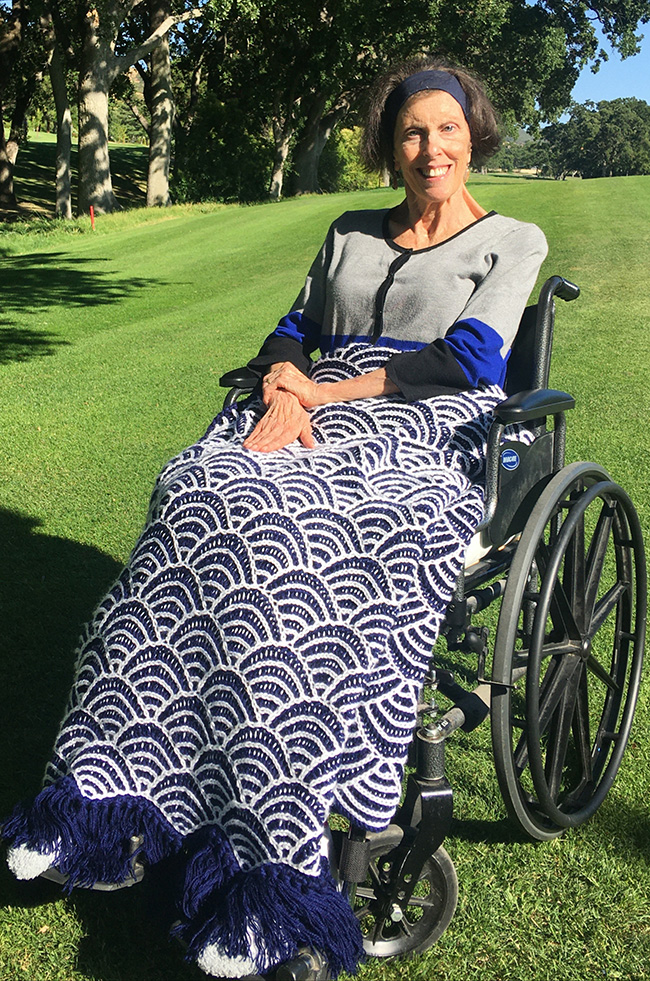 by Kimberly Kalnoki
by Kimberly Kalnoki
![]()
This eye-catching brioche blanket is inspired by Japanese sashiko embroidery done with white thread on indigo-dyed fabric. The bold, graphic stitch pattern is based on the traditional seigaiha wave motif.
The blanket is made with a super-bulky blue yarn and a worsted-weight white yarn, which creates an interesting variation of traditional two-color brioche without any added difficulty. The contrasting yarn weights give the navy blue background greater color dominance in the design, which is meant to reflect the pattern's inspiration of white embroidery stitches against a background of indigo fabric.
This pattern should be very approachable for any knitter who is familiar with two-color brioche knitting, because only one type of increase and decrease is used throughout the blanket to create the motif.
The stitch pattern was inspired by the "Ocean Waves" design from Nancy Marchant’s excellent book Knitting Fresh Brioche. The unwrapped brioche decreases were inspired by a Xandy Peters tutorial, but I use a slightly different method (see Pattern Notes) which I find to be easier for working with super-bulky yarn. If the knitter would prefer not to work unwrapped decreases, they can substitute traditional left-slanting brioche decreases for all of the decreases in the pattern.
This blanket was the first project that I designed after returning to knitting as an adult. It has been quite a lengthy process that involved knitting more than a dozen swatches and two full blankets, so I am very excited for the pattern to be published!
 model: KK
model: KK
 photos: AK
photos: AK
SIZE
One
FINISHED MEASUREMENTS
Width: 48 inches/122 cm
Length: 62 inches/158 cm (not including fringe)
MATERIALS
Yarn
![]() [MC] Universal Yarn Uptown Super Bulky [100% acrylic; 87 yd/80 m per 100g skein]; 414: Navy Blue; 15 skeins
[MC] Universal Yarn Uptown Super Bulky [100% acrylic; 87 yd/80 m per 100g skein]; 414: Navy Blue; 15 skeins
![]() [CC] Universal Yarn Uptown Worsted [100% acrylic; 180 yd/165 m per 100g skein]; 302: White Glow; 6 skeins
[CC] Universal Yarn Uptown Worsted [100% acrylic; 180 yd/165 m per 100g skein]; 302: White Glow; 6 skeins
Yarn characteristics:
The sample shown uses a worsted-weight yarn and a super-bulky yarn. These plied acrylic yarns are soft, bouncy, and machine washable.
Recommended needle size
[always use a needle size that gives you the gauge listed below - every knitter's gauge is unique]
![]() US #10.5/6.5 mm circular needle (40-inch/100-cm or longer, to accommodate large number of stitches)
US #10.5/6.5 mm circular needle (40-inch/100-cm or longer, to accommodate large number of stitches)
Notions
![]() stitch markers (optional)
stitch markers (optional)
![]() yarn needle
yarn needle
![]() crochet hook (for attaching fringe)
crochet hook (for attaching fringe)
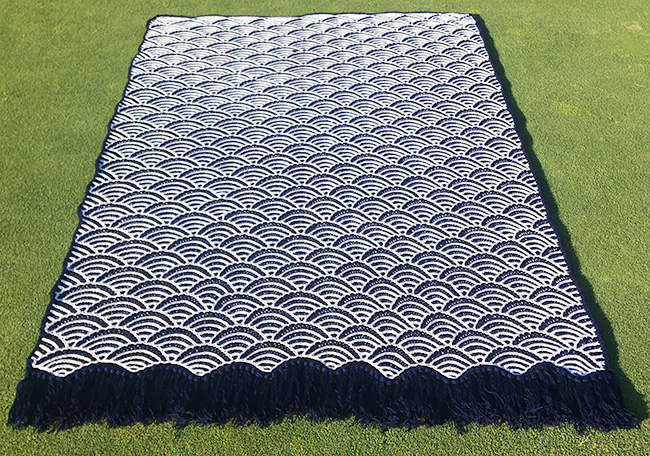
GAUGE
9 sts/12 rows = 4 inches/10 cm in St st on US #13/9 mm needle for MC alone
Approx 11 sts/16 rows = 4 inches/10 cm in pattern stitch
Note: 1 row of brioche consists of 1 row of CC and 1 row of MC
Aside from yardage requirements, gauge is not critical for this pattern, but knitting a blanket is a big investment of both yarn and effort, so it's definitely worth swatching to make sure that the look and feel of the finished fabric will be as desired. If the gauge is too tight, then the increases and decreases will distort the fabric three-dimensionally in a way that will prevent the scallops from laying flat.
PATTERN NOTES
[Knitty's list of standard abbreviations and techniques can be found here.]
The pattern begins along the left edge of the blanket.
It is easy to adjust the height of the blanket by altering the number of CO sts by a multiple of 10. The width of the blanket can be modified as desired by changing the number of rows that are worked.
A rows are always worked in CC.
B rows are always worked in MC.
It may be helpful to place stitch markers between each pattern repeat while working, but note that the markers will need to be removed and re-placed when working the combined decrease/increases of Rows 10A and 20A.
sl1yo:
- For even-numbered CC rows and odd-numbered MC rows: Bring the yarn to the front, slip the next st purlwise, and drape the yarn over the right-hand needle as you work the following brk stitch.
- For odd-numbered CC rows and even-numbered MC rows: With the yarn in the front, slip the next st purlwise; drape the yarn over the right-hand needle, bringing it to the front again so that it is ready to work the following brp stitch.
brk: Knit the stitch together with its accompanying yarnover.
brp: Purl the stitch together with its accompanying yarnover.
brkyobrk: Brioche knit, yarn over, brioche knit into a single stitch (increase from 1 st to 3 sts).
brLslUdec: Slip the first stitch and its wrap knitwise, knit the second stitch, pass the wrap of the first stitch off over the new stitch, return the stitch to the left needle without twisting, pass the third stitch and its wrap together off over the new stitch, slip the stitch purlwise to the right needle, pass the unwrapped first stitch off over the new stitch (decrease from 3 sts to 1 st).
brLslUdec+kyok: Work the brLslUdec, then return the newly-decreased stitch back to the left needle without twisting and work a k1, yo, k1 increase into the stitch (no change in st count).
CHARTS
Row 1A [WS] and all odd-numbered A rows: With CC, sl2, brp, (sl1yo, brp) to last 2 sts, sl2. Slide.
Row 1B [WS] and all odd-numbered B rows: With MC, p1, k1, sl1yo, (brk, sl1yo) to last 2 sts, k1, p1. Turn.
Row 2A [RS]: Sl2, [brkyobrk, sl1yo, brLsldec, sl1yo, (brk, sl1yo) three times] seventeen times, brkyobrk, sl1yo, brk, sl2. Slide. 2 sts increased.
Row 2B [RS]: K1, p1, [sl1yo, k1, (sl1yo, brp) five times] seventeen times, sl1yo, k1, sl1yo, brp, sl1yo, p1, k1. Turn.
Row 4A: Sl2, [brkyobrk, sl1yo, brk, sl1yo, brLslUdec, sl1yo, (brk, sl1yo) twice] seventeen times, brkyobrk, [sl1yo, brk] twice, sl2. Slide. 2 sts increased.
Row 4B: K1, p1, [sl1yo, k1, (sl1yo, brp) five times] seventeen times, sl1yo, k1, (sl1yo, brp) twice, sl1yo, p1, k1. Turn.
Row 6A: Sl2, [brkyobrk, sl1yo, (brk, sl1yo) twice, brLslUdec, sl1yo, brk, sl1yo] seventeen times, brkyobrk, [sl1yo, brk] three times, sl2. Slide. 2 sts increased.
Row 6B: K1, p1, [sl1yo, k1, (sl1yo, brp) five times] seventeen times, sl1yo, k1, (sl1yo, brp) three times, sl1yo, p1, k1. Turn.
Row 8A: Sl2, [brkyobrk, sl1yo, (brk, sl1yo) three times, brLslUdec, sl1yo] seventeen times, brkyobrk, [sl1yo, brk] four times, sl2. Slide. 2 sts increased.
Row 8B: K1, p1, [sl1yo, k1, (sl1yo, brp) five times] seventeen times, sl1yo, k1, (sl1yo, brp) four times, sl1yo, p1. Turn.
Row 10A: Sl2, (brk, sl1yo) five times, [brLslUdec+kyok, sl1yo, (brk, sl1yo) four times] seventeen times, brk, sl2. Slide.
Row 10B: K1, p1, (sl1yo, brp) five times, [sl1yo, k1, (sl1yo, brp) five times] seventeen times, sl1yo, p1, k1. Turn.
Row 12A: Sl2, brLslUdec, sl1yo, (brk, sl1yo) three times, [brkyobrk, sl1yo, brLslUdec, sl1yo, (brk, sl1yo) three times] seventeen times, brk, sl2. Slide. 2 sts decreased.
Row 12B: K1, p1, (sl1yo, brp) four times, [sl1yo, k1, (sl1yo, brp) five times] seventeen times, sl1yo, p1, k1. Turn.
Row 14A: Sl2, brLslUdec, sl1yo, (brk, sl1yo) twice, [brkyobrk, sl1yo, brk, sl1yo, brLslUdec, sl1yo, (brk, sl1yo) twice] seventeen times, brk, sl2. Slide. 2 sts decreased.
Row 14B: K1, p1, (sl1yo, brp) three times, [sl1yo, k1, (sl1yo, brp) five times] seventeen times, sl1yo, p1, k1. Turn.
Row 16A: Sl2, brLslUdec, sl1yo, brk, sl1yo, [brkyobrk, sl1yo, (brk, sl1yo) twice, brLslUdec, sl1yo, brk, sl1yo] seventeen times, brk, sl2. Slide. 2 sts decreased.
Row 16B: K1, p1, (sl1yo, brp) twice, [sl1yo, k1, (sl1yo, brp) five times] seventeen times, sl1yo, p1, k1. Turn.
Row 18A: Sl2, brLslUdec, sl1yo, [brkyobrk, sl1yo, (brk, sl1yo) three times, brLslUdec, sl1yo] seventeen times, brk, sl2. Slide. 2 sts decreased.
Row 18B: K1, p1, sl1yo, brp, [sl1yo, k1, (sl1yo, brp) five times] seventeen times, sl1yo, p1, k1. Turn.
Row 20A: Sl2, [brLslUdec+kyok, sl1yo, (brk, sl1yo) four times] seventeen times, brLslUdec+kyok, sl2. Slide.
Row 20B: K1, p1, [sl1yo, k1, (sl1yo, brp) five times] seventeen times, sl1yo, k1, sl1yo, p1, k1. Turn.
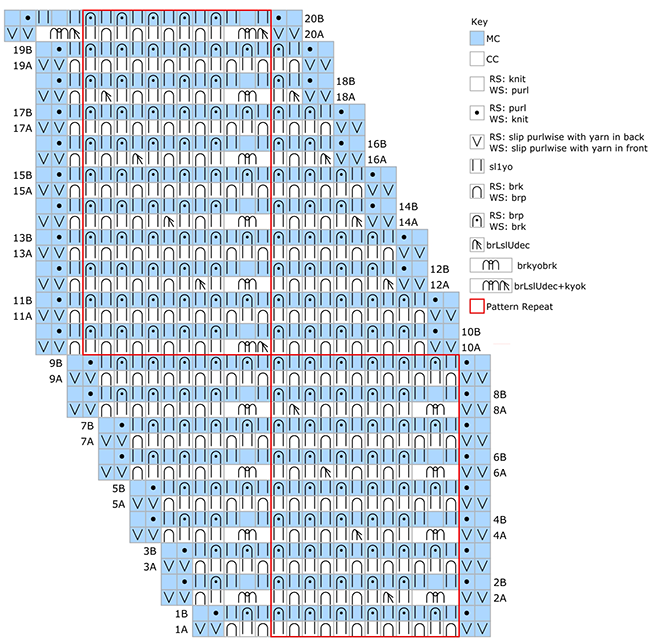
DIRECTIONS
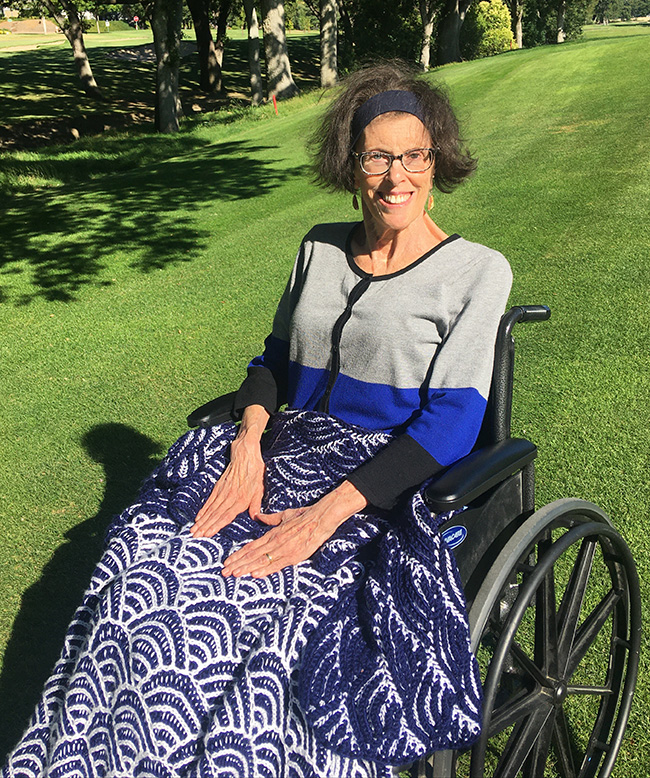
With MC held double, use the long-tail method to CO 175 sts. Cut second strand of MC, leaving a 6-inch/15-cm tail.
Set-up Row 1 [WS]: With MC, p1, [k1, sl1yo] to last 2 sts, k1, p1. Turn.
Join CC.
Set-up Row 2A [RS]: With CC, sl2, [brkyobrk, sl1yo, (brk, sl1yo) 4 times] 17 times, brkyobrk, sl2. Slide sts back to work with MC. 211 sts – 36 sts increased, 2 sts increased per rep and 2 additional sts increased at end of row.
Set-up Row 2B [RS]: With MC, k1, p1, [sl1yo, k1, (sl1yo, brp) 5 times] 17 times, sl1yo, k1, sl1yo, p1, k1. Turn.
Working from chart or written instructions, work Rows 1A-20B 8 times, then work Rows 1A-19B once more.
Cut CC, leaving a 6-inch/15-cm tail.
Final Row [RS]: With MC, k1, p1, [brLslUdec, (p1, brk) 4 times, p1] 17 times, brLslUdec, p1, k1. Turn. 175 sts – 36 sts decreased, 2 sts decreased per repeat and 2 additional sts decreased at end of row.
Bind off in ribbing pattern as set, starting with p1. Cut MC, leaving a 6-inch/15-cm tail.
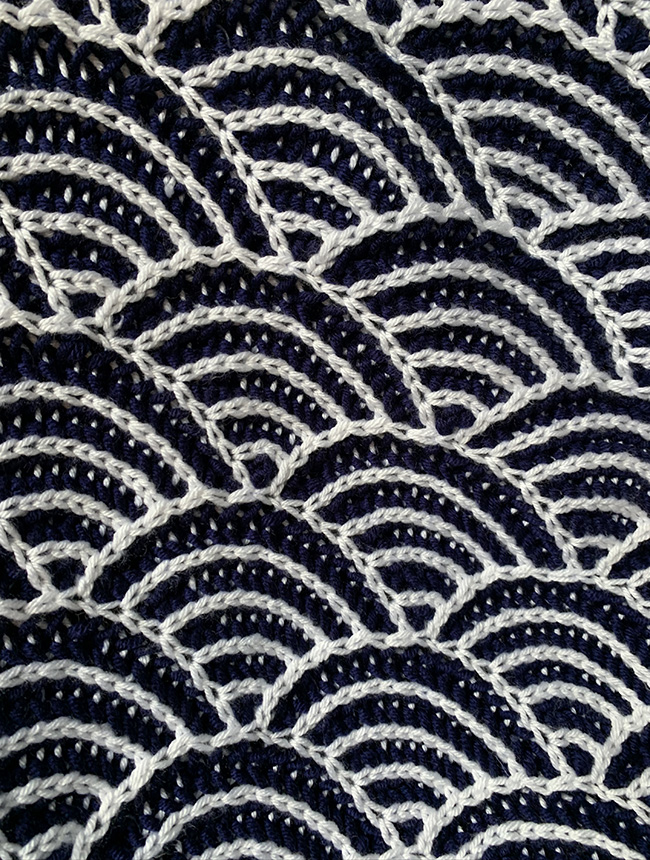
FINISHING
Weave in all ends. Cut 12-inch/30-cm pieces of MC to create fringe along the right selvedge edge (the bottom of the blanket). Add fringe with crochet hook, using 2 strands of yarn for each available st. Wash according to yarn care instructions, and either lay flat to dry or machine dry gently if yarn permits. Do not stretch or pin.
ABOUT THE DESIGNER
Kimberly learned to knit from a book as a teenager, then took a hiatus from knitting for about a decade, before returning to it with a passion in her late 20s. As a longtime vegan, she doesn't knit with any animal fibers, which motivated her to learn all that she could about yarn substitutions and eventually begin designing her own patterns.Find her on Ravelry.
Pattern & images © 2021 Kimberly Kalnoki